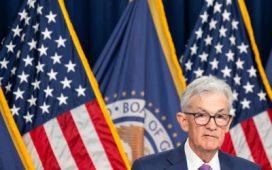WASHINGTON, Jan 26 — The US Federal Reserve’s favoured measure of inflation ticked higher last month, according to government data published today, indicating that its long-running battle against rising prices is not over yet.
The latest announcement will likely ensure the US central bank keeps interest rates on hold at its next decision announcement on Wednesday, as policymakers continue talks on when to start cuts.
The personal consumption expenditures (PCE) price index rose at an annual rate of 2.6 per cent last month, unchanged from November, the Department of Commerce said in a statement.
Advertisement
On a monthly level, headline PCE inflation rose by 0.2 per cent in December, up from a 0.1 per cent decline a month earlier. This was in line with market expectations, according to Briefing.com.
“We learned this morning that inflation was at the pre-pandemic benchmark of two per cent over the last six months of 2023,” US President Joe Biden said in a statement.
“That’s an important milestone that means more breathing room for working families,” he added.
Advertisement
Biden is running for reelection this year, and appears set to face former president Donald Trump, who is the front-runner in the fight for the Republican nomination.
Core inflation still falling
The closely watched “core inflation” measure, which strips out volatile food and energy costs, continued to ease, rising by 2.9 per cent in the year to December, and by 0.2 per cent from a month earlier.
This will likely reassure the Fed that trends are moving in the right direction, despite the latest uptick in headline prices.
“The inflation data support a shift in the FOMC’s policy stance this year, from holding rates steady to lowering them over time,” High Frequency Economics chief US economist Rubeela Farooqi wrote in a note to clients, referring to the rate-setting Federal Open Market Committee.
“The exact timing will depend on incoming data, on the labour market, inflation and growth,” she added.
Fed officials have taken to the airwaves recently to indicate that it is probably too soon to start lowering rates.
“While I think it’s appropriate for us to look forward and ask when would policy adjustments be necessary so we don’t put a stranglehold on the economy, it’s really premature to think that that’s around the corner,” San Francisco Fed president Mary Daly said this month.
But there is more clarity on next week’s decision: Futures traders currently assign a probability of more than 97 per cent that the Fed will remain on pause, according to CME Group.
Strong consumption
Today, Commerce Department data also showed a sharp acceleration in personal consumption expenditures, up 0.7 per cent in December from 0.4 per cent a month earlier.
This was the biggest month-to-month increase since January 2023, said Pantheon Macroeconomics senior US economist Kieran Clancy.
The personal savings rate declined sharply, to 3.7 per cent of disposable personal income from 4.1 per cent in the prior month.
“The boost to spending from excess savings accumulated during Covid is fading, but income growth is picking up the slack,” Clancy said, referring to the 0.3 per cent monthly rise in personal income last month. — AFP






